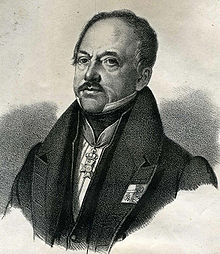Wilhelm Friedrich August von Leyßer
Wilhelm Friedrich August von Leyßer (born July 17, 1771 in Holzminden , † December 21, 1842 in Dresden ) was a German politician, manor owner and lieutenant general . He was the first President of the Second Chamber of the Saxon State Parliament .
Life

The son of Georg Ludwig von Leysser (1736-1773) and his wife Clara Augusta, born Leysser, grew up in the Saxon Switzerland on the manor Gersdorf that his grandfather, the Saxon Oberkonsistorialrat and secret war council Johann Gottlieb von Leysser belonged to. Later this property passed to his mother and was managed by Leyßer's stepfather Carl Gottlob von Ponickau and Pilgram , who owned three manors themselves.
In 1787, he followed private tuition from a private tutor at the universities of Wittenberg and Leipzig . In 1789 he entered the Saxon military service , initially as a sub-lieutenant in the Garde du Corps in Dresden . In 1795 he took over the Gersdorf manor from his mother. Leyßer was a participant in the Napoleonic Wars . In 1809 he served the commander of the Saxon troops, Prince Ponte Corvo, as an orderly . In recognition of his bravery demonstrated in the Battle of Wagram , he was awarded the Knight's Cross of the Military Order of St. Henry and the Cross of the Legion of Honor . In addition, he was appointed major . After his return to Saxony he became a wing adjutant to King Friedrich August I , from whom he was promoted to lieutenant colonel and commander of the guard regiment. As a colonel and brigadier, he led this unit during the Russian campaign in 1812 . He was seriously wounded and captured in the Battle of Borodino . In 1814 he was able to return to Saxony, where he immediately took command of a hussar regiment and later that of a cavalry brigade . Nudersdorf Castle, inherited from his unmarried uncle Friedrich Wilhelm von Leiser in 1784, was sold in 1815 to the Prussian chief forest master Alexander Ferdinand von Erdmannsdorf. During this time he was stationed in Colmar , Alsace , in 1815/16 , where he rose to major general . After his return to his home in Saxony, he intended to retire from military service in 1817 , but was placed à la suite so that he continued to serve the king. He retired to his country estate in Saxon Switzerland, where he devoted himself to extensive agriculture.
In 1820 he participated in the committee of the general knighthood at the Saxon Estates Assembly , where he was immediately elected director of the college. At the next state parliament in 1824 he became a member of the Further Committee of the Knighthood . In 1829 he was promoted to lieutenant general. At the last two meetings of the Saxon estates in 1830 and 1831 he was involved in drafting the first constitution of the Kingdom of Saxony. On the occasion of his 50th anniversary in service, Leyßer was awarded the Commander's Cross 2nd Class of the Military Order of St. Henry on February 25, 1832 in recognition of his bravery demonstrated in the campaigns of 1806 and especially in 1809 on the Moscow River. In the same year he said goodbye to the army.
As a representative of the "peasant class" he was elected to the second chamber of the first constitutional state parliament in 1833 and took over the office of chamber president. In the history of Saxon parliamentarism, he is one of the few nobles who did not receive his delegation to the II. Landtag Chamber from the manor owners. After the first state parliament he withdrew from politics. He died in Dresden in 1842 and was buried in Berggießhübel , where he had revitalized the bathing business in 1822.
literature
- Josef Matzerath : Aspects of Saxon State Parliament History. Presidents and members of parliament from 1833 to 1952. Dresden 2001, p. 57f.
- Josef Matzerath: Leyßer, August Friedrich Wilhelm von . In: Institute for Saxon History and Folklore (Ed.): Saxon Biography .
Web links
- Leyser . In: Heinrich August Pierer , Julius Löbe (Hrsg.): Universal Lexicon of the Present and the Past . 4th edition. tape 10 . Altenburg 1860, p. 331 ( zeno.org ).
Individual evidence
- ↑ Pfarrarchiv Luther community Holzminden: KB L.3. - as the birthplace also be in the literature falsely Braunschweig (eg in Pierers Universallexikon.) And Blankenburg in the Harz (as Josef Matzerath z. Aspects of the Saxon parliament story. ) Called
- ↑ The Royal Saxon Military St. Heinrichs Order 1736–1918. An honor sheet of the Saxon Army. Wilhelm and Bertha von Baensch Foundation, Dresden 1937, p. 53.
| personal data | |
|---|---|
| SURNAME | Leyßer, Wilhelm Friedrich August von |
| ALTERNATIVE NAMES | Leyser, August Friedrich Wilhelm von |
| BRIEF DESCRIPTION | Saxon lieutenant general and politician, first president of the second chamber of the Saxon state parliament |
| DATE OF BIRTH | July 17, 1771 |
| PLACE OF BIRTH | Holzminden |
| DATE OF DEATH | December 21, 1842 |
| Place of death | Dresden |


